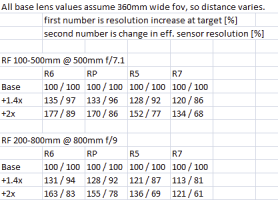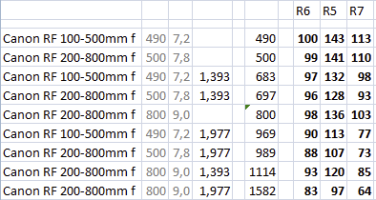Any chance of getting those formulas? I'd love to compare them to mine. Yours seem to be a bit more aggressive than mine.
Here are some values with mine. These are approximations of what happens when TC:s are added to a base lens while keeping aperture value the same.
Obviously resolution increase at target means smaller resolution value ie. more details. Perfect values for the 1.4x would be "140 / 100" and for 2x "200 / 100" .

Admittedly my calculations were originally meant for super macro, so some parts are a bit complicated for this and others can be too simplified.
Here are some values with mine. These are approximations of what happens when TC:s are added to a base lens while keeping aperture value the same.
Obviously resolution increase at target means smaller resolution value ie. more details. Perfect values for the 1.4x would be "140 / 100" and for 2x "200 / 100" .

Admittedly my calculations were originally meant for super macro, so some parts are a bit complicated for this and others can be too simplified.
Upvote
0


